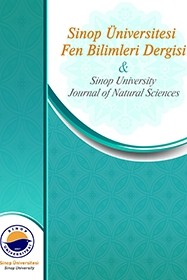İyon değiştirici reçine formunun sulardan fenol giderilmesindeki etkisi
adsorpsiyon, iyon değişimi, kinetik, fenol, Relite 2AS, atık su
The effect of ion exchange resin form on the removal of phenol from water
adsorption, ion exchange, kinetic, phenol, Relite 2AS, waste water,
___
- Caetano M, Valderrama C, Farran A, Cortina J L, 2009. Phenol removal from aqueous solution by adsorption and ion exchange mechanisms onto polymeric resins, J. Colloid Interf. Sci., 338(2): 402-409.
- Babich H, Davis D L, 1981. Phenol: A review of environmental and health risks, Regul. Toxicol. Pharmacol., 1(1):90-109.
- SivaKumar N A, Min K., 2011. Removal of phenolic compounds from aqueous solutions by biosorption onto Acacia leucocephala bark powder: Equilibrium and kinetic studies, J. Chil. Chem. Soc., 56(1): 539-545.
- Sulaymon A H, Abbood D W, Ali A H., 2013. A comparative adsorption/biosorption for the removal of phenol and lead onto granular activated carbon and dried anaerobic sludge, Desal. Wat. Treat., 51(10-12): 2055-2067.
- Zabneva O V, Smolin S K, Shvidenko O G, Klymenko N A., 2014. Biosorption removal of nitrophenols by activated carbon, J. Water Chem. Tech., 36(2): 97-101.
- Dixit A, Mungray A K, Chakraborty M., 2012. Photochemical oxidation of phenolic wastewaters and its kinetic study, Desal. Wat. Treat., 40(1-3): 56-62.
- Samsoni-Todorov A O, Rolya E A, Kochkodan V M, Goncharuk V V., 2008. Photocatalytic destruction of phenol in water in the presence of cerium hydroperoxide, J. Water Chem. Tech., 30(3): 151-156.
- Liu J, Xie J, Ren Z, Zhang W., 2013. Solvent extraction of phenol with cumene from wastewater, Desal. Wat. Treat., 51(19-21): 3826-3831.
- Cooney D O, Jin C L., 1985. Solvent extraction of phenol from aqueous solution in a hollow fiber device, Chem. Eng. Commun., 37(1-6): 173-1791.
- Koseoglu H, Harman B I, Yigit N O, Kabay N, Kitis M., 2011. The impacts of operational conditions on phenol removal by nanofiltration membranes, Desal. Wat. Treat., 26 (1-3): 118-123.
- Rolya E A, Kochkodan V M, Samsoni-Todorov A O, Goncharuk V V., 2008. The removal of phenol from aqueous solutions by means of a photocatalytic membrane reactor, J. Water Chem. Tech., 30(1): 32-37.
- İpek İ Y, Kabay N, Yüksel M, Yapıcı D, Yüksel Ü., 2012. Application of adsorption–ultrafiltration hybrid method for removal of phenol from water by hypercrosslinked polymer adsorbents, Desalination, 306: 24-28.
- Carmona M, DeLucas A, Valverde J L, Velasco B, Rodríguez J F., 2006. Combined adsorption and ion exchange equilibrium of phenol on Amberlite IRA-420, Chem. Eng. J. 117(2):155-160.
- Ku Y, Lee K C, Wang W., 2005. Removal of Phenols from Aqueous Solutions by Purolite A‐510 Resin, Separ. Sci. Technol., 39(4): 911-923.
- Streat M, Sweetland L A., 1997. Physical and adsorptive properties of Hypersol-Macronet TM polymers, , React. Funct. Polym., 35(1):99-109.
- Zhu L, Deng Y, Zhang J, Chen J., 2011. Adsorption of phenol from water by N-butylimidazolium functionalized strongly basic anion exchange resin. J. Colloid Interface Sci., 364(2):462-468.
- El-Naas M H, Al-Zuhair S, Alhaija M A., 2010. Removal of phenol from petroleum refinery wastewater through adsorption on date-pit activated carbon, Chem. Eng. J., 162(3): 997-1005.
- Chasanov M G, Kunin R, McGarvey F., 1956. Sorption of phenols by anion exchange resins, Ind. Eng. Chem., 48(2):305-309.
- Ku Y, Lee K C., 2000. Removal of phenols from aqueous solution by XAD-4 resin, J. Hazard. Mater., 80(1): 59-68.
- Alyüz B, Veli S., 2009. Kinetics and equilibrium studies for the removal of nickel and zinc from aqueous solutions by ion exchange resins, J. Hazard. Mater., 167(1):482-488.
- Nandi B K, Goswami A, Purkait M K., 2009. Adsorption characteristics of brilliant green dye on kaolin, J. Hazard. Mater., 161(1):387-395.
- Zhang J, Zhou Q, Ou L., 201. Kinetic, isotherm, and thermodynamic studies of the adsorption of methyl orange from aqueous solution by chitosan/alumina composite. J. Chem. Eng.Data, 57(2):412-419.
- Ho Y S, McKay G., 1999. Pseudo-second order model for sorption processes, Process Biochem., 34(5):451-465.
- Ho Y S., 2006. Review of second-order models for adsorption systems, J. Hazard. Mater., 136(3): 681-689.
- Cortina J L, Arad-Yellin R, Miralles N, Sastre A M, Warshawsky A., 1998. Kinetics studies on heavy metal ions extraction by Amberlite XAD2 impregnated resins containing a bifunctional organophosphorous extractant, React. Funct. Polym., 38(2):269-278.
- Zagorodni A A, 2006. Ion exchange materials:properties and applications. First edition. London: Elsevier
- Levenspiel, O. 1972. Chemical Reaction Engineering.3th edition. New York: John Wiley& Sons.
- ISSN: 2536-4383
- Yayın Aralığı: 2
- Başlangıç: 2016
- Yayıncı: -
Kategorik Verilerde Kümeleme İçin Farklı Algoritmaların Karşılaştırılması
Yaygın Kullanımlı Antibiyotiklerin Konvansiyonel Arıtma Tesislerinde Giderimi
Bahar İKİZOĞLU, Fatma İlter TÜRKDOĞAN
İyon değiştirici reçine formunun sulardan fenol giderilmesindeki etkisi
Özge SANDIKÇI, Ayşegül PARMAKSIZ, Arzu KOCAOĞLU, Özgür ARAR, Ümran YÜKSEL
Soğutucu Akışkan Distribütöründe İki Fazlı Akışın Bilgisayarlı Simülasyonu
Mehmet Selçuk MERT, Merve SERT, Gökçen ÖZKARA, Fikret YÜKSEL
